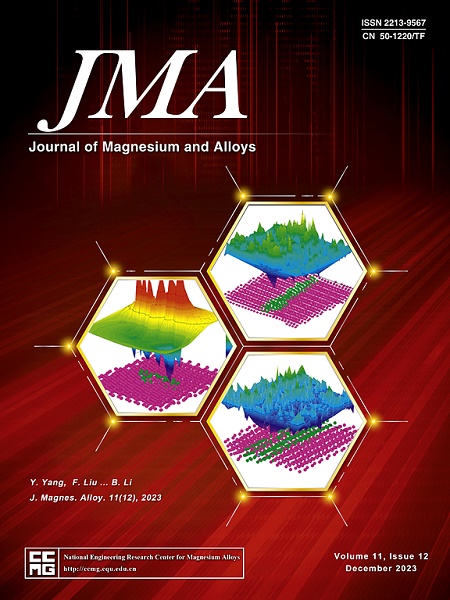不同烧结温度下 AZ91D 合金的微观结构和机械性能
IF 15.8
1区 材料科学
Q1 METALLURGY & METALLURGICAL ENGINEERING
引用次数: 0
摘要
在制备 AZ91D 镁合金时,通过调节火花等离子烧结的烧结温度可实现晶粒细化、相位控制和性能提升。本研究探讨了烧结温度对 AZ91D 合金微观结构演变和机械性能的影响。使用扫描电子显微镜、电子反向散射衍射和 X 射线衍射进行了微观结构分析。通过硬度和拉伸试验检验了微观结构和机械性能。烧结温度升高导致次生相含量减少,从而降低了机械性能。合金在 320°C 时表现出最佳的机械性能。利用相场方法模拟了烧结过程中纳米颗粒的粗化过程和颗粒演化过程。通过优化烧结温度,可以实现对微观结构和纹理演变的精确控制,从而达到理想的硬度水平和机械性能。本文章由计算机程序翻译,如有差异,请以英文原文为准。
Microstructure and mechanical properties with different sintering temperature of AZ91D alloy
The regulation of sintering temperature in spark plasma sintering enables the achievement of grain refinement, phase control, and performance enhancement in the preparation of AZ91D magnesium alloy. This study investigates the influence of sintering temperature on microstructural evolution and mechanical properties of the AZ91D alloy. Microstructural analysis was conducted using scanning electron microscopy, electron backscatter diffraction, and X-ray diffraction. Microscopic structures and mechanical behaviors were examined through hardness and tensile tests. Elevated sintering temperatures resulted in reduced secondary phase content, leading to a decrease in mechanical performance. The alloy exhibited optimal mechanical properties at 320°C. The nanoparticle coarsening process and particle evolution during sintering were simulated using phase field methods. By optimizing the sintering temperature, precise control over microstructural and textural evolution can be achieved, facilitating the attainment of desired hardness levels and mechanical properties.
求助全文
通过发布文献求助,成功后即可免费获取论文全文。
去求助
来源期刊

Journal of Magnesium and Alloys
Engineering-Mechanics of Materials
CiteScore
20.20
自引率
14.80%
发文量
52
审稿时长
59 days
期刊介绍:
The Journal of Magnesium and Alloys serves as a global platform for both theoretical and experimental studies in magnesium science and engineering. It welcomes submissions investigating various scientific and engineering factors impacting the metallurgy, processing, microstructure, properties, and applications of magnesium and alloys. The journal covers all aspects of magnesium and alloy research, including raw materials, alloy casting, extrusion and deformation, corrosion and surface treatment, joining and machining, simulation and modeling, microstructure evolution and mechanical properties, new alloy development, magnesium-based composites, bio-materials and energy materials, applications, and recycling.
 求助内容:
求助内容: 应助结果提醒方式:
应助结果提醒方式:


